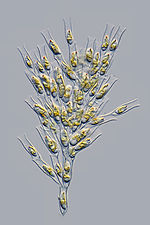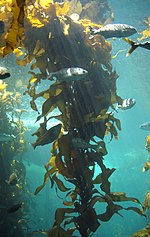Fucoxanthin is a xanthophyll, with formula C42H58O6. It is found as an accessory pigment in the chloroplasts of brown algae and most other heterokonts...
9 KB (826 words) - 03:44, 2 September 2024
from eutrophication and acid rain. Chrysophytes contain the pigment fucoxanthin. Because of this, they were once considered to be a specialized form...
16 KB (1,596 words) - 10:06, 11 October 2024
are chlorophylls a and c, they also possess a yellow carotenoid called fucoxanthin, this is responsible for their unique and characteristic color. They...
2 KB (165 words) - 19:34, 14 January 2022
compound in wakame known as fucoxanthin may help burn fatty tissue in mice and rats. Studies in mice have shown that fucoxanthin induces expression of the...
26 KB (2,699 words) - 19:19, 6 October 2024
other heterokonts, the plastids of yellow-green algae do not contain fucoxanthin, which is why they have a lighter color. Chartreuse yellow is used on...
10 KB (748 words) - 03:22, 21 October 2024
around it. Fucoxanthin-containing chloroplasts are characterized by having the pigment fucoxanthin (actually 19′-hexanoyloxy-fucoxanthin and/or...
189 KB (19,143 words) - 04:06, 11 November 2024
xanthophylls in green algae, phycoerythrin in red algae (rhodophytes) and fucoxanthin in brown algae and diatoms resulting in a wide variety of colors. These...
110 KB (11,776 words) - 19:26, 12 November 2024
aquaculture industry. This unicellular is investigated for its high amount of fucoxanthin (18.23 mg/g dried sample). The Isochrysis galbana extract is said to...
4 KB (402 words) - 05:51, 1 April 2024
eukaryote and a red or green alga. Most brown algae contain the pigment fucoxanthin, which is responsible for the distinctive greenish-brown color that gives...
59 KB (5,869 words) - 02:48, 21 November 2024
having four cell membranes and containing pigments such as the carotenoid fucoxanthin. Individuals usually lack flagella, but they are present in male gametes...
148 KB (15,312 words) - 18:17, 21 November 2024
other Stramenopiles (heterokonts), their chloroplasts do not contain fucoxanthin, which accounts for their lighter colour. Their storage polysaccharide...
18 KB (1,595 words) - 23:03, 18 October 2023
These pigments in addition to chlorophylls, are phycobiliproteins, fucoxanthins, xanthophylls and carotenes, which serve to trap the energy of light...
32 KB (3,908 words) - 20:24, 18 April 2024
Sashima, Tokutake; Funayama, Katsura; Miyashita, Kazuo (2005-07-01). "Fucoxanthin from edible seaweed, Undaria pinnatifida, shows antiobesity effect through...
32 KB (3,936 words) - 04:23, 4 August 2024
between the HF-Tiso group and CTRL rats. T. lutea contains fucoxanthin as well. Fucoxanthin, a carotenoid pigment synthesized in brown algae, counter-act...
7 KB (837 words) - 20:47, 15 December 2023
and gamma- carotenes. Like diatoms and brown algae, they have also fucoxanthin, an oxidized isoprenoid derivative that is likely the most important...
18 KB (1,517 words) - 16:51, 13 November 2024
(found in red peppers), renieratene (from Japanese sea sponges) and fucoxanthin (the most abundant carotenoid found in seaweed). Other compounds whose...
5 KB (489 words) - 08:16, 17 August 2024
green tea as its basis, in combination with other plant extracts such as fucoxanthin, found naturally in seaweed. Drugs of this class are frequently stimulants...
18 KB (1,871 words) - 01:10, 17 October 2024
grooves first found in Tasmanian and South African waters. It contains fucoxanthin and its derivatives as its main accessory pigments. Takayama helix has...
2 KB (182 words) - 17:04, 15 June 2023
or brown because of the presence of chlorophyll a, chlorophyll c, and fucoxanthin. This form of plastid is called a stramenochrome or chromoplast. The...
33 KB (3,303 words) - 12:05, 31 August 2024
products contain the allene functional group. Noteworthy are the pigments fucoxanthin and peridinin. Little is known about the biosynthesis, although it is...
40 KB (4,305 words) - 04:10, 21 August 2024
contain chlorophylls a and c as photosynthetic pigments, in addition to fucoxanthin. Chlorophyll a binds to thylakoids, while the c pigment is present in...
41 KB (4,136 words) - 18:52, 16 October 2024
3'-dihydroxy-2,3,2',3'-tetradehydro-β,β-carotene-4,4'-dione dipalmitate Fucoxanthin 3'-Acetoxy-5,6-epoxy-3,5'-dihydroxy-6',7'-didehydro-5,6,7,8,5',6'-hexahydro-β...
44 KB (5,282 words) - 02:45, 2 November 2024
dorsal chloroplast that contains chlorophylls a and c1-3 as well as fucoxanthin. They are typically 1-2 μm in size and generally spherical or heart-shaped...
7 KB (641 words) - 21:59, 5 July 2024
grooves first found in Tasmanian and South African waters. It contains fucoxanthin and its derivatives as its main accessory pigments. Takayama tasmanica...
2 KB (206 words) - 12:08, 30 January 2023
micrum have acquired other pigments through endosymbiosis, including fucoxanthin. This suggests their chloroplasts were incorporated by several endosymbiotic...
96 KB (10,337 words) - 09:25, 5 November 2024
sides of the cells, and contain chlorophyll a, c, beta-carotene and fucoxanthin pigments. One or two pyrenoids are usually present in each chloroplast...
4 KB (389 words) - 22:23, 11 May 2023
distinctive golden color to the cells, which comes from chlorophyll c1 and fucoxanthin. Cells are covered with scales made of silica. Two flagella are present...
5 KB (426 words) - 13:12, 11 August 2024
system by damaging calcium ions in cells. Fucosterol, diterpenes, and fucoxanthin are also found in Padina which can slow down the spread of malignant...
13 KB (1,450 words) - 12:33, 5 January 2024
contain several natural products such as carotene, chlorophyll a, and fucoxanthin (the pigment responsible for the brown color of phaeophycean seaweeds)...
11 KB (1,179 words) - 23:21, 19 October 2024
multiple yellowish-green chloroplasts containing chlorophyll a and c2, fucoxanthin, violaxanthin, antheraxanthin, zeaxanthin and b-carotene. Each cell presents...
9 KB (942 words) - 20:12, 3 September 2023























